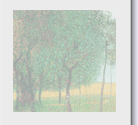| Visualization of trees |
|
KLIMT offers many different views of the hierarchical structure of a tree. Nodes are represented by rectangles which can be either of equal size or proportional to the number of cases in the node. Arrangement of the nodes can be either regular, optionally with terminal nodes in one line, or ruled by some property of the tree, such as the node size, predicted value or mean in each node. Connecting lines can be rectangular, straight or proportional to the size of the destination node. The tree can be plotted either vertically or horizontally.
Regardless of the layout used, the user is free to re-order nodes of the tree. Individual nodes or entire branches can be moved by dragging. The logical zoom and panning features are useful especially for larger trees.
|
| Alternative visualization of trees |
|
Trees are more than just hirearchical structures. They partition the observation space orthogonally. This property can be visualizaed by treemaps which are implemented in KLIMT. A similar idea is used in enhanced scatterplots, where the enhancement consists of delineating areas corresponding to the partitions. A quick overview of the terminal nodes is given by spineplots of leaves.
|
| Interactive pruning and tree construction |
It is possible to interactively prune the tree. Less important branches can be cut off and the resulting tree is displayed and evaluated along with the original tree for comparative purposes.
KLIMT features a Split Editor and mountain plots to allow interactive construction trees or modification and analysis for existing trees.
|
| Plots |
KLIMT provides a wide variatey of fully interactive standard plots:
- histograms
- barcharts, spineplots
- scatterplots
- boxplots (also by group)
- fluctuation diagrams
- weighted plots
Most plots allow interactive change of parameters, such as changing the bin width of a histogram by dragging the bin-width handle.
|
| Context sensitive queries |
|
In most plots context sensitive queries are provided. They allow instant identification and quantification of displayed information at a glance. Extended queries offer additional information, such as summary statistics.
|
| Linked highlighting |
All plots in KLIMT are linked together by highlighting. KLIMT supports linking on two levels:
- case-level
Every case highlighted in one plot is correspondigly highlighted in all other plots, including the trees
- node-level
Selecting a node causes node-relevant information to be displayed in all related plots, such as the corresponding partition in an enhanced scatterplot.
In KLIMT any selection changes are propagated immediately to all related plots (hot linking).
|
| Interfaces |
KLIMT offers various interfaces to the widely-used statistical packages R/S/S-plus. Three different interfaces are availiable:
-
Flat-files interface
allows execution of KLIMT within R/S/S-plus and the use of tree-growing methods. Works on most platforms and doesn't need any additional software, but is the least versatile alternative.
-
Rserve interface
allows the use of R within KLIMT for tree construction and other tasks. The interface is much faster that flat-files, but needs R and Rserve.
-
SJava interface
allows parallel use of R/S/S-plus and KLIMT in both directions. Especially useful for embedding KLIMT in R, so that KLIMT can be controlled completely by R functions.
|
| Import/Export |
|
KLIMT accepts datasets in tab-separated ASCII format, or as files produced by the default write.table command in R. Missing values are supported and should be denoted by "?", "NA" or the n/a symbol (Mac platforms only). KLIMT produces informative warnings if there are problems with the dataset.
Trees are retireved in the ASCII format as used by the tree and rpart libraries.
Selected cases or entrire datasets can be exported from KLIMT in ASCII tab-separated format. All plots in KLIMT can be saved in vector formats (Encapsulated PostScript, Windows Metafile or PoGraSS metafile). Such exported files can be edited with most vector-oriented editing tools or directly printed. KLIMT uses its own Portable Graphics SubSystem to allow flexible conversion into most popular formats.
|
| Forest analysis |
|
KLIMT supports the analysis of entire tree forests. Multiple trees can be loaded simultaneously and are then automatically linked. Overall statistics of all nodes can be generated and analyzed. KLIMT also automatically generates special variables for each tree including predicted values, the terminal node ID for each case, residuals and misclassification counts. These are valuable for comparing different tree models.
|
| Availability |
KLIMT is available on all popular platforms: Linux, MacOS 9 and X, Windows, Solaris and AIX. KLIMT has been tested on all these platforms and should work on any platofrm that supports Java JDK 1.1.
Certain features that rely on external tools, such as embedded tree construction, are not available on all platforms. Effort was made to make the Rserve and flat-file interface available for most platforms. |





















